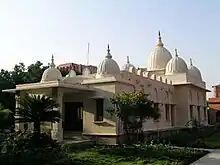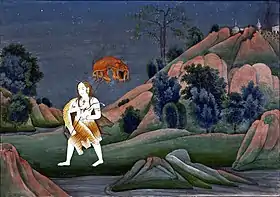Kankhal
कनखल | |
|---|---|
 Kankhal Location in Uttarakhand, India  Kankhal Kankhal (India) | |
| Coordinates: 29°56′N 78°09′E / 29.93°N 78.15°E | |
| Country | |
| State | Uttarakhand |
| District | Haridwar |
| Elevation | 260 m (850 ft) |
| Languages | |
| • Official | Hindi |
| Time zone | UTC+5:30 (IST) |
| PIN | 249408 |
| Telephone code | 01334 |
| Vehicle registration | UK |
| Website | haridwar |
Kankhal is a small colony in Haridwar[1] in the Haridwar district of Uttarakhand state in India.
Mentioned in the Vayu Purana and the Mahabharata as Kanakhala,[2][3] Kankhal is one of 'Panch Tirth' (Five Pilgrimages) within Haridwar, with other spots being Gangadwara (Har ki Pauri), Kushwart (Ghat in Kankhal), Bilwa Teerth (Mansa Devi Temple) and Neel Parvat (Chandi Devi Temple).[4][5]
It is most known for the Daksheswara Mahadev Temple, Maa Anandamoyi Ashram and numerous other ashrams and old houses with exquisite wall paintings built by Hindu pilgrims in the 19th century.[1]
Kankhal in scriptures
Kankhal is mentioned in Mahabharata as follows,
"Here, O king, before thee is the Kanakhala range, the favourite resort of sages. 'And yonder is the mighty river Ganga. Here, in ancient times, the holy sage Sanatkumara attained ascetic success. O scion of the Ajamidha race, by performing thy ablutions here in this river, thou wilt be freed from all thy sins.
"Bathing in Gangadwara (Haridwar) and Kusavarta...as also in Kankhala, one is sure to become cleansed of all one's sins and then ascend to heaven."
History


Traditionally, Kankhal is considered to be the summer capital and Kurukshetra the winter capital of Shiva. God Shiva after ascending to the throne visited plain areas, the present Haridwar.
In the Vanaparva of the Mahabharat, where sage Dhaumya tells Yudhishthira about the tirthas of India, Gangadwar, i.e., Haridwar and Kankhal, have been referred to.[7] Kankhal also finds mention in the poem Meghaduta (Cloud messenger), of the 3rd century AD, classical Sanskrit poet and dramatist, Kalidas.[2]
When the first Sikh Guru, Guru Nanak (1469–1539), visited Haridwar in 1504 AD, on the Baisakhi day, he went on to visit Kankhal, en route to Kotdwara in Garhwal.[8] Kankhal also finds mention in the travel accounts of Sister Nivedita (1867–1911), a disciple of Swami Vivekananda, wherein she mentions that long before Haridwar became popular, Kankhal had been a center for education and pilgrimage [9]
As late as early 19th century it used to be a separate town, from Haridwar and Mayapur in the areas,[10] though due to urban development it now falls within the city limits of Haridwar.
Work on the Upper Ganges canal commenced in April 1842, between Haridwar and Kankhal.[11] Apart from being home various temples and ashrams of various sects, Kankhal also has numerous old havelis, mansion, now visitors attraction, especially heritage tours. Mostly built in previous century, they are known for their frescoes and haveli architecture, and were built by princely states, and zamindars for their stay in the pilgrimage town during summer months.
Geography
Kankhal is located at 29°56′N 78°09′E / 29.93°N 78.15°E.[12] It has an average elevation of 260 metres (853 feet).
Important places in Kankhal






- Daksheswara Mahadev Temple - Kankhal is most known for the ancient temple of Daksheswara Mahadev temple,[13] situated in the south Kankhal town. The present temple was built by Queen Dhankaur in 1810 AD [14] and rebuilt in 1962.[2][15][16] Next to the temple is the 'Daksha Ghat' on the Ganges, and close by is the Nileshwar Mahadev Temple. Much of the details of the famous Ashvamedha Yagna (Horse Sacrifice) of Daksha are available in the Vayu Purana[2]
- Sati Kund, another well-known mythological heritage worth visit is situated in the Kankhal region. Legend has it that Sati laid down her life in this kund [5]
- Ramakrishna Mission Sevashrama [17] - Ramakrishna Mission Sevashrama, Kankhal [ RKMS ], situated in the city of Haridwar [ Uttarakhand ], is a 150-bed multi-specialty charitable hospital founded in 1901 at behest of Swami Vivekananda to cater to the medical needs of this region. In its long odyssey spanning over a century, it has grown in size, widening the spectrum of services to meet the varied dimensions of health hazards and during this time it has treated more than 10 million patients.RKMS has been instrumental in presenting a road map for bridging the impoverished society – modern treatment methodology and has proved to be the lodestar for the healthcare units. Its altruistic approach of treatment, an umbilical and hence a distinguishing feature from its inception, caught the attention of luminaries like Mahatma Gandhi, * Sir J C Bose etc. who visited this centre. Being the oldest Ashrama ( after Ramakrishna Home of Service, Varanasi) of the Ramakrishna Order, this Sevashrama bears the hallowed memory of several direct disciples of Shri Ramakrishna Paramhamsa. Swami Brahmananda, Swami Turiyananda and Swami Niranjanananda spent their time in intense spiritual practice in this Ashrama.
- Anandamoyi Ma Ashram - This quaint ashram was the residence of this Hindu saint Sri Anandamoyi Ma (1896–1982), and also houses her samādhi shrine and a museum dedicated to her, in the vicinity.[18]
- Abheda Ganga Mayya AsramThe ashram is under a trust called Abheda Ganga Mayya Trust. The fFounder of the trust was Bhajananda Swamiji, the main disciple of Swami Abhedananda Maharaj. It is currently headed by Swami Krishnanda.
- Dera Baba Dargah Singh ji, Gurudwara - Situated near Sati Ghat, this Gurudwara is dedicated to the third Sikh Guru, Guru Amar Das, who visited this place many times during his lifetime,[19][20] is situated near Sati Ghat in Kankhal; it is managed by the Nirmala Sikhs, a scholarly sect of the Sikhs, who came here in 1705, after evacuating from Anandpur, Punjab and made it their headquarters [21]
- Gurukul Kangri University - Situated in Kankhal, on the banks of river Ganges, on Haridwar-Jwalapur bypass road, Gurukul Kangri is one of the oldest Universities of India, founded in 1902 by Swami Shraddhananda (1856–1926), according to the tenets of Swami Dayananda Saraswati, the founder of Arya Samaj. It was visited by British Trade Union leader Charles Freer Andrews and British Prime Minister, Ramsay MacDonald,[22] to study the unique Gurukul based education system. Mahatma Gandhi visited its campus three times,[22] and stayed in its sprawling and serene campus for extended periods of time, most notably in 1916, when on 20 March, he spoke at Gurukul Anniversary.[23]
Transport
Kankhal is well connected by road to National Highway 58, between Delhi and Manapass. Nearest railway stations are at Jwalapur and Haridwar. The nearest airport is Jolly Grant Airport, Dehradun, though Indira Gandhi International Airport in New Delhi is preferred.
See also
References
- 1 2 A study of Kankhal
- 1 2 3 4 Vishnu Purana Sacrifice of Daksha (From the Vayu Purana.) The Vishnu Purana, translated by Horace Hayman Wilson, 1840. p. 62, "In former times, Daksha commenced a holy sacrifice on the side of Himaván, at the sacred spot Gangadwara, frequented by the Rishis. The gods, desirous of assisting at this solemn rite, came, with Indra at their head, to Mahadeva, and intimated their purpose; and having received his permission, departed in their splendid chariots to Gangadwára, as tradition eports.” 62:2 Gangadwára, the place where the Ganges descends to the plains--or Haridwar, as it is more usually termed--is usually specified as the scene of action, The Linga (Purana) is more precise, calling it Kanakhala, which is the village still called Kankhal, near Haridwar.(Megha Dúta, p. 63 p. 59). p. 68 I am called Virabhadra, the issue of the wrath of Rudra. Bhadrakálí also, who has sprung from the anger of Devi…
- 1 2 Bathing in Gangadwara….. as also in Kankhala The Mahabharata translated by Kisari Mohan Ganguli (1883 -1896], Book 13: Anusasanika Parva: Section XXV, p. 130.
- ↑ Travel guide Haridwar
- 1 2 Kankhal Archived 22 November 2008 at the Wayback Machine www.indiainfoweb.com.
- ↑ Kanakhala The Mahabharata, Book 3: Vana Parva: Tirtha-yatra Parva: Section CXXXV.
- ↑ Historical, Cultural and Social Perspectives Chapter 3, The Cultural Dimension Of Ecology, Baidyanath Saraswati, 1998, Indira Gandhi National Centre for the Arts. ISBN 81-246-0102-X. ignca.nic.in. Vanaparva (The Book of the Forest) is third parva (book) of the Mahabharata.
- ↑ Janasakhi Archived 24 March 2012 at the Wayback Machine Janamsakhis of Miharban and Mani Singh, mention this visit to have taken place on the Baisakhi day in 1504 AD. Janamsakhi Tradition, Dr. Kirpal Singh, 2004, Punjabi University, Patiala. ISBN 81-7205-311-8. p. 92. www.globalsikhstudies.net.
- ↑ Kedar Nath & Badri Narayan - A Pilgrim's Diary. Sister Nivedita, 1928, p. 10-11. www.vivekananda.net.
- ↑ History The Imperial Gazetteer of India, v. 21, p. 371.
- ↑ Upper Ganges Canal The Imperial Gazetteer of India 1909, v. 12, p. 138.
- ↑ Falling Rain Genomics, Inc - Kankhal
- ↑ Haridwar
- ↑ Places around Haridwar
- ↑ the Horse-sacrifice of the Prajapati Daksha The Mahabharata translated by Kisari Mohan Ganguli (1883 -1896], Book 12: Santi Parva: Mokshadharma Parva: Section CCLXXXIV. p. 317. "I am known by the name of Virabhadra’’ and I have sprung from the wrath of Rudra. This lady (who is my companion), and who is called Bhadrakali, hath sprung from the wrath of the goddess."
- ↑ Story of Daksha's sacrifice and Sati-Shakti
- ↑ Ramakrishna Mission Sevashrama Kankhal
- ↑ Anandamayi ma Ashram
- ↑ Itihas Gurudwara Guru Amaradas ji, Kanakhala Bishan Singh Kreet. Pub. Diyal Siṅgha Niraṅkari, 1950. (Punjabi) Microform. worldcat.org.
- ↑ Janamsakhi Archived 24 March 2012 at the Wayback Machine Guru Granth Sahib p. 1116-1117.
- ↑ Nirmala www.sikhcybermuseum.org.
- 1 2 Gurukul Archived 24 May 2008 at the Wayback Machine Official website of Haridwar.
- ↑ Chronology of Mahatma Gandhi's life/India 1916 Wiki Source.
